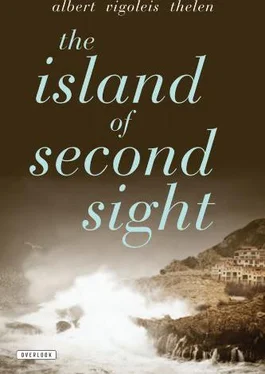At this point in our discussion of Baruch’s christological myth, Belita’s mother, the austere Doña María Augusta, felt it her duty to intervene with all the imposing strength of her personality, which was all the more awe-inspiring on the basis of her income from the Quinta do Vesúvio, where Portugal’s finest port vineyards are located. She felt insulted by the barbarity of this American fable, which touched on matters of faith and morals. Another elderly aristocratic lady went even further, declaring that she had heard from an unimpeachable source that the Ambassador could trace his lineage directly back to Christ Himself. Old Dr. Baruch himself could not have worked things out with such precision. He could be satisfied with the genealogical seed that he had already sown.
It would be just as foolhardy to cast doubt upon the historicity of Dr. Baruch as it would be to call into question the nature of the historical Christ. Christ’s fate as a historical person, along with its much-discussed Palestinian local flavor, is certain. And that is a shame, or perhaps even disastrous for humanity. For if Christianity had based its mission on nothing at all, it would only be a dream, a figment of the imagination or of poetry, and it could never have degenerated to the degree that we are witnessing today with fear and trembling. In the book he wrote about his own experience of Christ, “The Christ of Travassos,” my friend Pascoaes makes a statement that is a significant step toward the mystical de-historicization of the figure of the Savior. He says that Christ entered the world with the first tear that was ever shed, at a place that was later to bear the name Bethlehem. The Christians of the Crusades, the ecclesiastical battles over politics, and the Holy Tunic of Trier are unwilling to accept such an insight. They need the open wound that they can place their fingers into. That is human nature. But every religion that traces its origins to a human founder has failed precisely as a result of human nature.
Mentir comme un généalogiste , a French proverb proclaims. Baruch’s cleverly planted family tree was a first-rate diplomatic achievement, one that contributed more to the Portuguese citizenry’s understanding of the American people than all the cultural missionaries sent to the country. Until his arrival, whoever judged the USA on the basis of its “crippled” president, the “gangster” Roosevelt, now had to concede with surprise and shame that there were people living in the States who had a lineage that was pleasing to God, people with mammoth family trees that were just as firmly rooted as any in the Old World, trees that no conceivable windstorm could topple. Reaching up into the heavens, such trees, fertilized by countless human corpses, were totems around which one could dance the Dance of Death, a favorite form of sacrifice for any and every god.
“Love is blind,” says an old adage that has so often proven true that it has entered the universal consciousness and is cited in all the compendiums of famous quotations. Accordingly, the Commissioner of Immigration Police for All the Balearics was blind in his love for the little bitch he was still cradling in his arms. What a miserable cur this was that he adored so much! What kind of ancestors might Dr. Baruch have dreamed up for this flea-bag? Next to such a mutt, Mamú’s Imperial lap-dog looked decidedly regal as he approached his little mistress on his invisible walking-props.
The Commissioner set the bride down on the lawn next to T’uang, who provided himself a parasol by raising his tail above his back — a most majestic gesture. It wasn’t until I saw T’uang next to the policeman’s nameless pug that I understood why, for millennia, the Chinese emperors imposed the death penalty on anyone who exported this race of dogs. It seemed certain that anybody smuggling the Police Commissioner’s deviant canine variant into the Central European Reich would likewise fall under the executioner’s axe.
As I have explained, Mamú’s yard was a park, albeit a very small one. Rabindranath, with the ludicrous dignified gait that is natural to his species, was able to cross it lengthwise in just a few minutes, and could get across the breadth of it in no time at all, with the help of a few hops and a flapping of wings. In the photos that Bobby took for Mamú’s family album, this tiny plot of earth takes on the dimensions of the palm grove at Elche; a flower of the order scorsonera , photographed from the top of a ladder, gives the impression of a segment of the Garden of Eden. The photographic plate is, after all, much more of a liar than the so highly suspect printed word. Don Juan Sureda knew very well why he didn’t include a single photograph in his archive of alibis. What judge would ever base his decision on a photo as evidence? Not even spiritualists would dare such a thing.
As soon as T’uang figured out why an in-bred mongrel was getting placed in front of his snooty nose, he scurried away to find a hiding place in Mamú’s primeval park of beautiful illusions. Neither Joseph at the house of Potiphar, nor Vigoleis on the Street of Solitude, had acted any less instinctively, although their proffered mates were of a rather different species. No matter how much he might enjoy sniffing or even mounting a canine female, Mamú’s Pekingese was responding to his own millennia-long bloodline. Now, confronted by a strange bitch and threatened with a Maríage de convenance , he balked and simply took a powder.
Mamú was ecstatic. “Children, those five thousand dollars were worth it! Here you have proof of the blue blood from the kennel of my friend Nikolaus!” But Mamú’s children were anything but ecstatic when they saw T’uang creeping off into the bushes.
When the rejected bride, whose progenitors seldom felt a leash around their necks, attempted to dart after the cute little lap-doggie, the Police Commissioner grabbed her by the fur and held her back. He knew what was right and proper behavior for a bridal ceremony. This was a sign for Bobby and me to intervene. We did what hunters do in similar situations: we beat the bushes. But the little Imperial guy was nowhere in sight; we would never catch the escapee without ruining the manicured shrubbery. Bobby, the refugee from the Folkwang Art School, put on his Cultural Bolshevist face, made a few silent calculations, and then started poking a long bamboo pole into the bushes. His microscopic left eye, doubtless the secret of his success as a typographer, but at the time a detriment to his hunting skills, took on a look of desperation. That little Chinese twerp was evading the attempts of a kid from the city of Essen to jerk him forth from the greenery! Then he skidded into a hole in the ground left by Mamú’s pet rabbits. What now? That’s when I had my Great Idea.
The raven has had a terrible reputation ever since the days of the god Odin. With his jet-black coloration he is the incarnation of evil itself; he is said to be capable of hacking out the eyes of his own progeny. If he ever becomes extinct — which Brehm says is quite likely — all of civilization will have lost its most graphic symbol of the battlefield. On the other hand, the raven has also been clever enough to gain renown as a beneficent creature. Mythologists can point to ravenous escapades that are little short of ingenious. Apollo employed ravens as divine messengers. Lusitanian charcoal-burners sing the praises of ravens that fly ahead of lost hikers, guiding them to the nearest human habitation. And then there is the bird’s amazing memory. The raven is a maniacal scavenger, one that can locate hiding places years after the fact. And besides, this particular raven had taken a strong disliking to Mamú’s Asiatic doggie. I cried out, “Rabindranath! I’ll release the raven!”
Читать дальше












